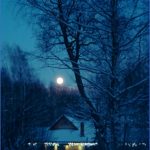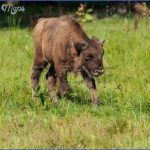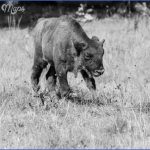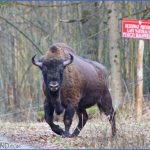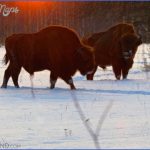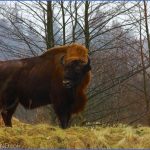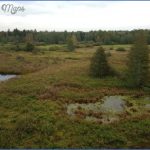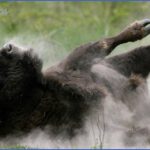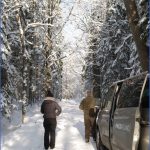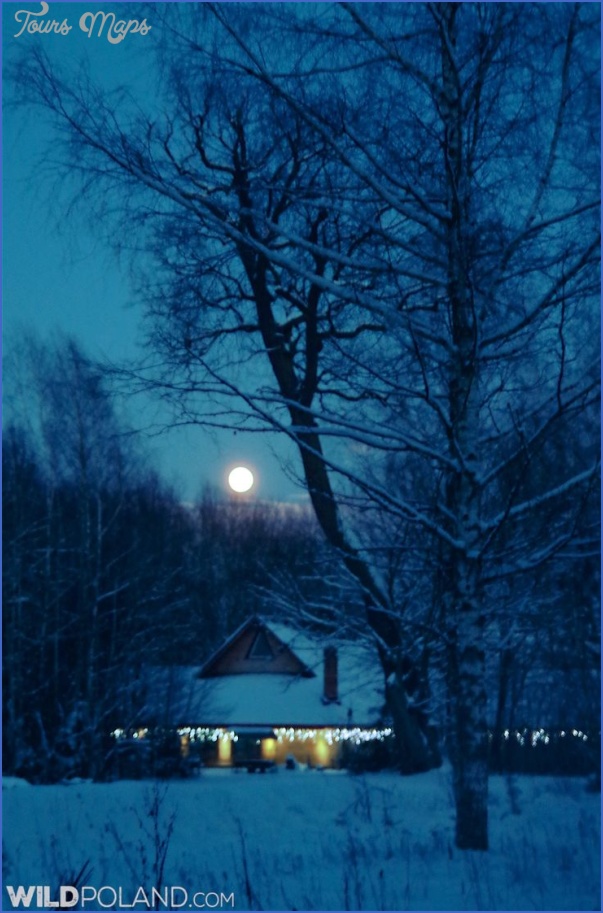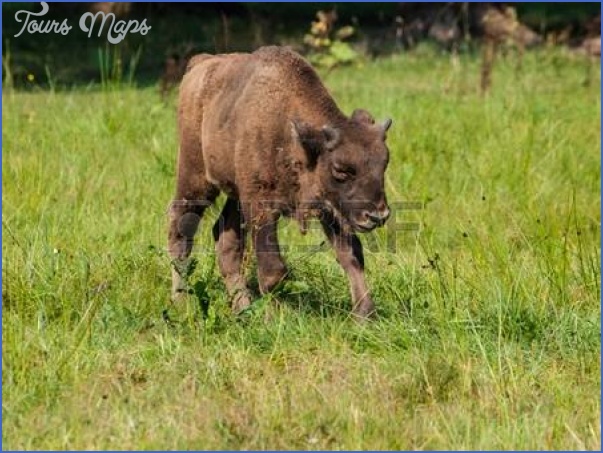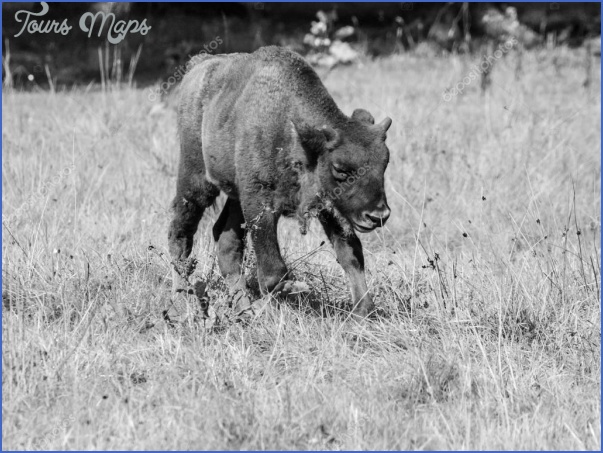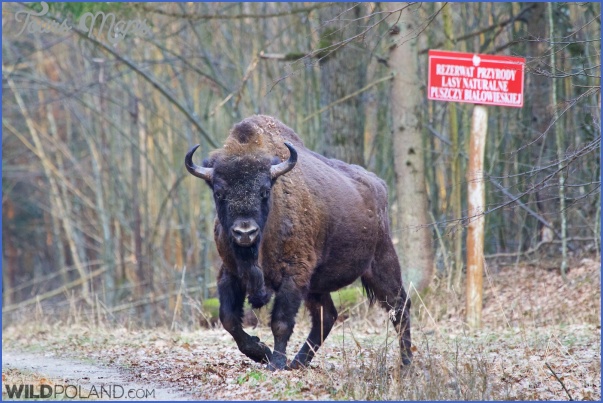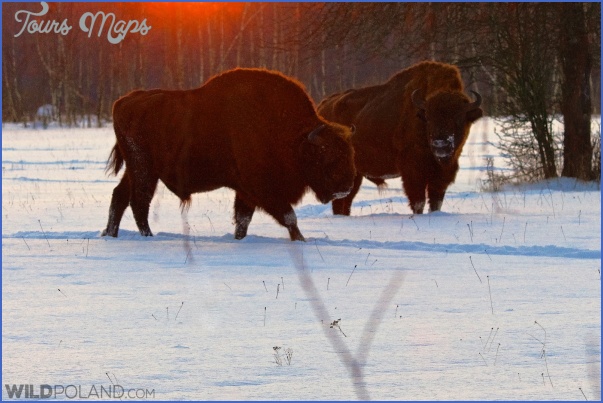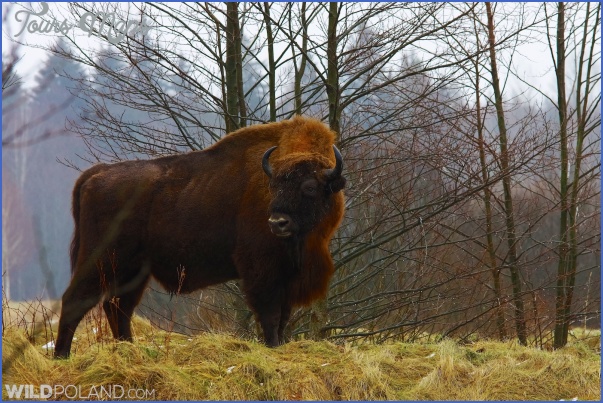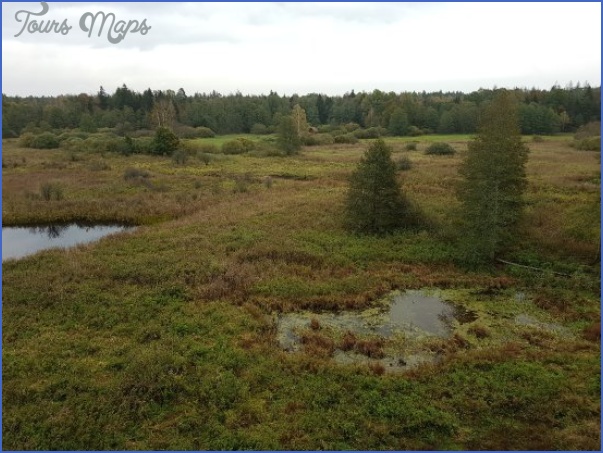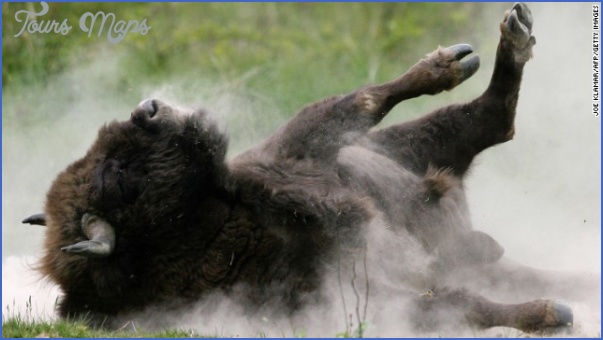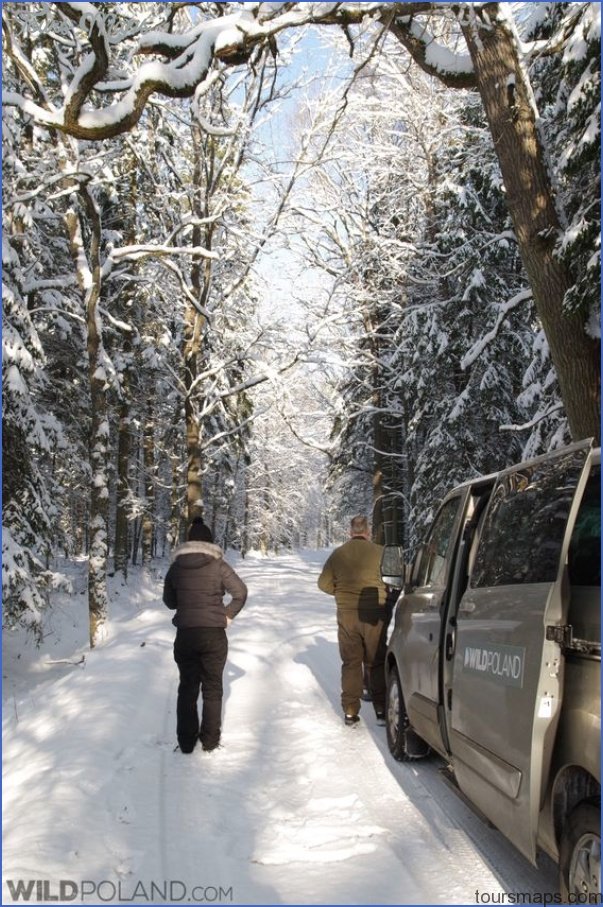We had stopped in a spot where we could see some forest edge after sunset but before the evening’s light had faded. And there we waited, constantly scanning from side to side. A scatter of moving lumps in the short-cropped meadows turned out to be hares. A few deer came into sight at the forest’s edge, obviously coming out for some rather different night-time grazing. The only other wildlife we could spot in the gathering gloom – more correctly they spotted us – were mosquitoes and some other undetermined biting insects. We waited, but no bison appeared. By now the light was fading steadily and we changed position, stopping where we had a view in a different direction and where we could see a longer length of forest edge. Wisps of mist were starting to form ghostly strands near the damp ground; it was a reminder of our previous apres-dawn trip.
Then we spotted one. It had walked out of the forest some distance away but its ominous bulk was perfectly recognisable with binoculars in the darkening gloom. First one bison, then another and, eventually, a third; walking slowly out from the trees about 400 m away to graze on the lush, succulent meadow flowers and grasses unobtainable in most of the forest. The hay crop was high but we could still see their huge bodies with their enormous, bearded, triangular-shaped heads hanging down. After a few minutes the mist was thickening, the light extinguished and we could only just make out some bison shapes. We left them there, spending their dark hours grazing while we retreated to the comfort of our small, family-run hotel in Bialowieza village.
Bialowieza Safari Photo Gallery
There is a lot more wildlife interest at Bialowieza than just the bison. In essence this is the best preserved lowland natural forest in Europe with an exceptionally rich range of plants and animals that have survived nearly unchanged ever since the forest first grew up. Bialowieza boasts well over 1,000 different plant species, over 4,000 different fungi, and more than 700 lichens, mosses, liverworts and slime moulds. Many of the fungi are rare or extinct in other managed forests because they are utterly dependent on dead timber which is usually cleared away. Although some of it is managed commercially, one large section is left completely natural with no forest management. Here, any old-age trees that fall, any storm damage, or any other changes that take place naturally are allowed to happen without interference. It is one of the very few areas of forest in Europe left to its own devices.
I arranged to visit this sector with a guide to have an early morning walk. One of the most obvious features was the sheer amount of decomposing timber, the richest habitat in any forest. There was a scatter of dead standing trees and several particularly old denizens that had fallen to the forest floor and were rotting away steadily. It is because of all this dead timber that a cornucopia of fungi and vast numbers of wood-boring beetles and other invertebrates burgeon. The split-open tree stumps and fallen tree trunks might look like battlefield corpses but these are the basis for much of the forest’s wildlife, something that’s often in very short supply in most forests across Europe, Britain included. Pock-marked by beetle boreholes and sporting clumps of bracket fungi in several colours, this dead timber supports a vast array of species. Somewhere around 10,000 different species of invertebrate live here, my guide told me, maybe more. No one’s checked them all out. Seemingly, though, that total does include well over twenty different mosquito species and I can vouch personally for some of them testing out their annoying biting behaviour.
In places, the towering tree canopy of oaks, limes, ash and spruce soared to 40-50 m and some of the largest trees are thought to be well over half a millennium old. They were an impressive sight though I found it virtually impossible to identify any small birds so high up in the canopy … and got a very stiff neck trying to do so. We saw several of the nearly 30 different tree species here, from poplar and hornbeam to alder and hazel; streamside marshes, open pools, sedge beds, glades and small meadows added to the diversity leaving me in little doubt that this is one of the wildlife wonders of Eastern Europe.
I was at Bialowieza in mid-summer, not the best time to see most of the forest birds. They had finished breeding and long ceased singing to advertise their territories. But the flute-like, rather exotic calls of the striking, primrose and green Golden Orioles rang out in places and I spotted a family group of Common Rosefinches, including an adult male with his bright, scarlet-flushed head and breast. All of Europe’s woodpeckers are here and, on various walks, we had heard the loud calls of a Black Woodpecker in the distance and had good views of both the Great Spotted and Middle Spotted Woodpecker, all species I had seen before. The one that eluded me was that much rarer species apparently confined to forests with a generous supply of rotting timber and mature trees: the White-backed Woodpecker. So where better than Bialowieza!
Then one day, I was walking along a path in the forest adjacent to some waterlogged ground and shallow pools in which there were a good proportion of standing dead trees, mainly birch. It was maybe a couple of kilometres into the forest from Bialowieza village towards the Belarus border. I was aware of something landing on one of these stems, stopped and searched with binoculars and – somewhat crestfallen – realised that it was a Great Spotted Woodpecker. I kept looking around and I noticed another woodpecker, or so I thought, a few trees away. I assumed it might be the Great Spotted’s mate. But this one seemed a little larger. I suddenly had a clear view of both of them with their backs facing me, each of them climbing up a different tree stem. The larger one had the tell-tale ‘ladder-back’ pattern of white rather than the larger white patches of the Great Spotted. It was a White-backed.
I don’t doubt that in spring the forest here is alive with the harsh calls and drumming of woodpeckers, with the songs of warblers and the evocative flutes of shy Golden Orioles. Like the orioles, they are not frequently seen but Bialowieza is also home to Elk, Red and Roe Deer, Wild Boar, Pine Martens, numerous bats and many other mammals … as well as to European Bison. Today, Bialowieza Forest (both the Polish and Belarus sides) is a World Heritage Site, a Biosphere Reserve and the Polish half is a Special Area of Conservation designated by the EU Habitats Directive, all designations that emphasise that this magnificent place is not only of Polish or Belarusian importance; it’s of European and world heritage value, a precious asset that must never be squandered.
But in this place of beauty and wildlife riches there is conflict too. ‘In Poland conservationists are uncommon beings,’ Adam Wajrak, nature correspondent for Poland’s biggest daily paper, Gazeta Wyborcza and a Bialowieza village resident, tells me. ‘Polish people are very different to those in the west. They don’t save energy. But they are very connected to nature. Most of us have grandparents living in the countryside, some farmers, some foresters, and we spend holidays there. I am surprised how much emotion comes out. If they tried to cull wolves here, as they did in Sweden, there would be demonstrations in the street.’
‘The Bialowieza Forest is public property; it belongs to all citizens of Poland and not to local communities and foresters,’ Professor Wesolowski explains. ‘The conflict is not between conservationists and foresters as foresters love to frame it but between stakeholders at large [70% of Poles want the Bialowieza Forest to be protected] and a small group of people with vested interests in timber exploitation, mainly local foresters and loggers. We propose to protect the whole area as a national park [only a sixth of the Polish side is national park now] and we see no place for commercial timber production or exploitation here.’
‘The creation of a national park doesn’t mean that no exploitation would be allowed. No one proposes to make the whole forest a strictly protected area. There would be some ‘no enter’ zones but otherwise the forest would be open for low impact use (collection of fungi and berries, tourism, research). We also propose to allow limited fuel wood extraction to cover the needs of local communities,’ he says. So far, the Polish Government, harangued by foresters and local interests on one side and by conservationists and academics, plus international pressure on the other, is seemingly doing nothing about it.
Wesolowski is far from optimistic. ‘It is impossible to enlarge the park in our current legal system in which local community councils have a veto right. They can block establishment or enlargement of the park forever, without giving any reason. It takes only eight people, the majority of the Bialowieza commune council, to block enlargement of the park against the will of the rest of society. This is democracy Polish way. We are trying to change this stupid law in the parliament, but so far without success.’
Wesolowski likes to compare the forest with the Hubble space telescope. ‘Hubble revolutionised astronomy by allowing scientists to peer back in time with unprecedented clarity but there’s a key difference with Bialowieza,’ he says. ‘If Hubble gets damaged, it can be replaced. This primeval forest cannot be bought or reconstructed.’ And Adam Wajrak echoes this view. ‘We are a country destroyed by wars and here there is not much heritage left apart from nature. This is the one unique thing we can give to the world.’
Maybe You Like Them Too
- DUBAI UNITED ARAB EMIRATES
- Anniston Map
- Wildlife Travel Guide
- Wildlife Travel To Alonissos
- National Wildlife Travel

